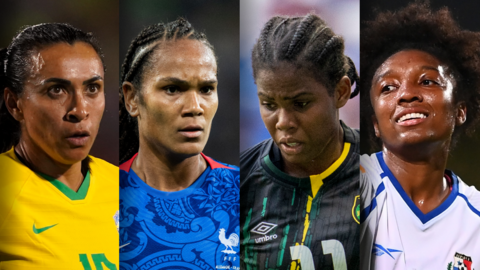- This year’s Women’s World Cup has seen record-breaking crowd numbers, broadcast ratings and jersey sales.
- But a stark disparity remains between the prize pool on offer for the women compared to their male counterparts.
- FIFA announced the total prize money for the women’s tournament is US$110 million ($170 million).
After already making history in the FIFA Women’s World Cup, the Australian team, the Matildas, are gearing up for a spot in the final – and the country is behind them.
On Wednesday night, they will take on England in the semi-final, with the winner set to face Spain in the final on Sunday.
This year’s home tournament has produced a groundswell of support for the Australian team, and for women’s sport, with record-breaking crowd numbers, broadcast ratings and jersey sales.
Despite this, a stark disparity remains between the prize pool on offer for the women compared to their male counterparts.
Here’s how much the winners will take home, along with other facts about the World Cup – from previous winners, to first wins and number of footballs used.

What prize money is on offer for the Women’s World Cup?
Earlier this year, global football body FIFA, the organiser of the World Cup, announced the total prize money for the women’s tournament was US$110 million ($170 million).
It was part of a US$152 million ($235 million) package including preparation funding and club benefits.
This year’s amount is almost four times the US$30 million offered in 2019, and about seven times more than 2015, when it was US$15 million .
Despite this, it remains around one quarter of the US$440 million ($682 million) that the men’s teams competed for in Qatar last year.

Total prize money on offer for the 2022 Men’s World Cup and the 2023 Women’s World Cup. Source: SBS News
The total prize money will be distributed among the football associations of the 32 teams in the tournament based on allocations announced by FIFA.
A victory for the Matildas in Sunday’s final would mean governing body Football Australia (FA) receives US$4.3 million ($6.6 million). This compares to the US$42 million ($64.6 million) earned by Argentina for winning the men’s tournament last year.
This year, FIFA will also allocate individual payments to players, on top of what their teams stand to earn.
Players will earn at least US$30,000 ($47,000) for being part of the group stage, and this amount increases based on their progress through the tournament.
Making it through the quarter-finals in their nail-biting victory against France will mean the Matildas each earn at least US$90,000 ($140,000). That would increase to US$270,000 ($419,000) if they reach and win the final.
Prize money for FIFA Women’s and Men’s World Cups since 2006. Source: SBS News
How many people have attended the Women’s World Cup so far?
This year’s Women’s World Cup has seen record attendances so far – and the numbers continue to grow.
According to the latest figures from FIFA, 1.77 million tickets have been sold and total match attendance across 60 of 64 matches sits at 1,734,028.
The highest match attendance to date has been 75,784 on three occasions (each time in Sydney), with the average being 28,900.
Match attendance across Women’s World Cups from 1991 to 2023. Source: SBS News
The previous record was the 1,353,506 people who attended the 52-match tournament in Canada in 2015. At the last Women’s World Cup in France in 2019, 1,131,312 fans attended 52 matches, with an average match attendance of 21,765.
Who has won the Women’s World Cup before?
The Women’s World Cup was officially recognised by FIFA in 1991, with the tournament entering its ninth rendition in 2023.
The USA has been a dominant force, taking out four titles in the first eight tournaments: 1991, 1999, 2015 and 2019.
Other victorious countries include Norway (1995), Germany (2003 and 2007), and Japan (2011).
Past winners of the FIFA Women’s World Cup since 1991. Source: SBS News
This year, a first-time winner will be lifting the trophy, with England, Spain and Australia in the running at time of writing.
Which teams have had their first win at a World Cup tournament?
Several teams – and tournament debutants – have recorded their first-ever wins at a Women’s World Cup this year.
New Zealand kickstarted their campaign with a 1-0 win against Norway in the group A opener – the team’s first ever FIFA Women’s World Cup victory.
Jamaica also claimed their first ever tournament win, defeating Panama 1-0 in the group stage. The squad went on to become the first Caribbean nation to reach the Round of 16, after ending Brazil’s campaign with a 0-0 draw. They bowed out with a 1-0 loss to Colombia.
Several teams have had their first World Cup win in this year’s tournament. Source: SBS News
Morocco made their debut as the first Arab team to qualify for the tournament – and the history-making didn’t stop there. After a 6-0 opening loss to Germany, the Atlas Lionesses defeated South Korea 1-0 in their second group stage encounter – their first Women’s World Cup victory.
Player Nouhaila Benzina also made history as
the first woman to wear a hijab at the tournament
. France defeated Morocco in their Round of 16 clash.
Which teams have scored the most goals?
Alongside the team glory, the Golden Boot will be awarded to the player who scores the most goals at the Women’s World Cup.
So, how are the teams faring so far?
Highest goal-scoring teams from the Women’s World Cup up to and including the quarter-finals. Source: SBS News
Up to and including the quarter-finals, Spain and Japan were in the lead with 15 goals apiece, followed by the Netherlands and France with 12.
The Matildas have scored nine goals so far.
How many footballs have been used?
The number of footballs used in the group stage of the Women’s World Cup. Source: SBS News
And, if you were wondering how many footballs have been used, FIFA is keeping score.
In the Women’s World Cup group stage, it said 1,536 Adidas footballs were provided to teams for training, and 1,280 official match balls were used.
@SBS News

